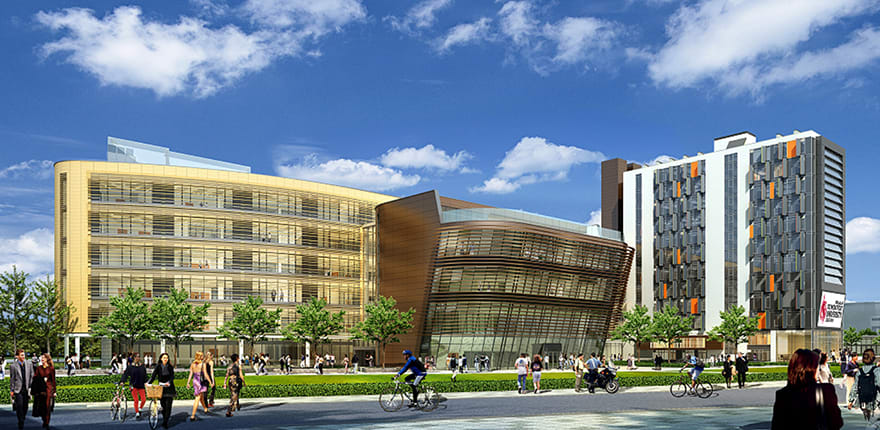- Client: De Montfort University
- Lead Contractor: Balfour Beatty
- BIM Tools: Autodesk Navisworks, Revit
Architect CPMG’s BIM implementation for a major new campus building at De Montfort University in Leicester involved a mix of traditional and advanced techniques, including clash detection “by eye” in Navisworks and combining Revit with an AutoCAD massing model of existing buildings.
The project is currently on site with contractor Balfour Beatty. The £43m Fletcher Complex for Art and Design is a 10,000 sq m full refurbishment of an 11-storey tower, an adjacent low rise steel building and a six-storey new build. It will house art & design studios, workshops, student services facilities, breakout and display spaces, a large catering outlet and the DMU Confucius Institute, designed to promote Chinese language and culture.
BIM is being used to coordinate the design of both buildings, however a lack of certainty or definition from the client on how BIM should be implemented has led to a “halfway house” approach combining traditional and digital design techniques.
Dawn Briggs, project architect at CPMG Architects, comments: “When we won the project, through a competition, in June 2013, De Montfort University had a desire to use BIM, without fully understanding what it could bring to a project. All the lead designers agreed to use Revit-compatible software, but no formal processes were set in place to run the project using BIM, and no BIM coordinator role was established. As lead designer CPMG assumed that role.”
3D Revit models were produced by CPMG and structural engineer Curtins, while M&E consultant Pick Everard exported Revit files from its own proprietary software. Although BIM is not being used by Balfour Beatty for programme or costing aspects, it did appoint Arup to develop a more detailed M&E model based on the performance-spec 3D model produced by Pick Everard.

The £43m Fletcher Complex for Art & Design is a 10,000 sq m full refurbishment of an 11-storey tower
The consultants uploaded Revit models and Navisworks files to a central extranet site on a weekly basis, ready to be shared and interrogated. Unusually, no formal clash detection process was carried out in Navisworks, as no requirement for it had been set in place by the client.
“Instead, it was a case of each team walking around, virtually, in the most recent model and looking for anything amiss,” says Briggs. “If anything was spotted, an email was sent, for example, to the structural engineer warning that a beam was out of position and the curtain walling would not fit. It has been a more old-fashioned approach of talking to each other, and spotting issues by eye, rather than getting the computer to do the work for us.”
The project has been one of several trial BIM projects for CPMG, more recent projects run full clash detection and by January 2016 CPMG will have the ability to run full BIM Level 2 (PAS 1192) projects, when requested, she adds.
The De Montfort project created certain coordination issues within the software that had a knock-on effect on building services arrangements and other features.
“It has been a continuous learning curve to ensure we are not making changes that compromise the other consultants’ models,” says Briggs. “The M&E engineers work using defined ‘spaces’ and we work using ‘rooms’. Spaces are very dependent on any changes we make to room layouts and if we start moving things around, for example a wall or a floor, we soon after get phone calls saying they have broken spaces. It is hard to say if this has been caused by a software incompatibility, or something else.”
The refurbishment of the Fletcher Complex is a challenge as there were no drawings of the existing concrete-framed tower or the steel-framed building, so CPMG crteated its own massing model of the tower in Revit which was used to co-ordinate the structure.
The client had proposed that a full 3D laser scan be carried out, but only after the main contractor was appointed, which was too late for the consultants’ design coordination work.
“Trying to pull together the architectural Revit model in combination with the CAD drawings was very complex, and we were unwilling to issue this information formally to the rest of the team as we didn’t want the risk of owning a structural model that might not be 100% accurate,” says Briggs
Due to the sheer scale of the project, CPMG’s initial Revit model had to be split down into four separate zoned models, two for the refurb and two for the new build, with all issued PDF sheet files stored in a fifth model.
“Although we have relatively high spec PCs, they inevitably become sluggish when the model size exceeds 100MB. As a result of this trial, CPMG now divides all its major building projects into zones and doesn’t attempt to manage everything in a single model,” concludes Briggs.
When we won the project, through a competition, in June 2013, De Montfort University had a desire to use BIM, but as with most clients at the time they didn’t fully understand what that meant or how they might make use of it.– Dawn Briggs, project architect at CPMG Architects











